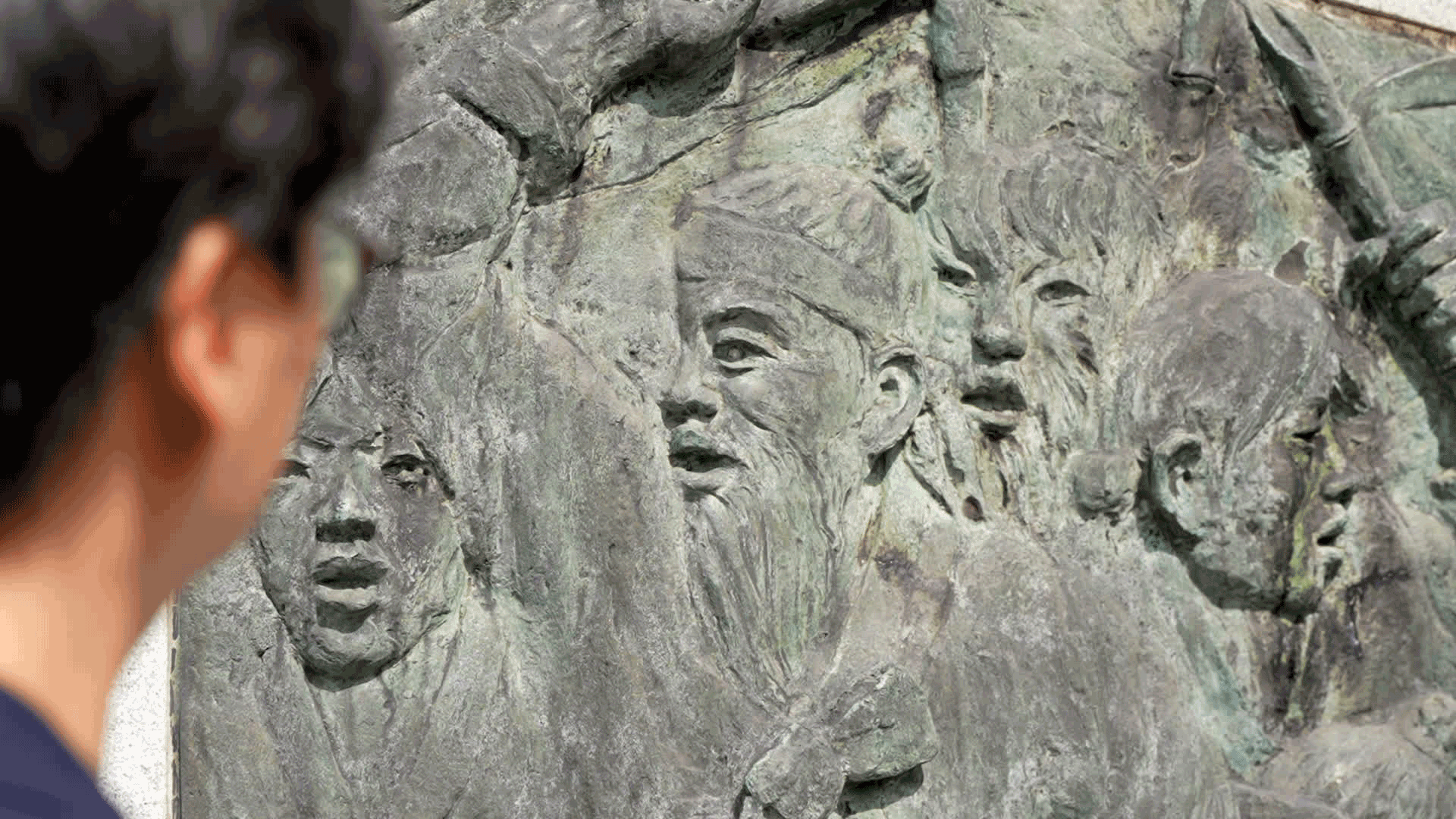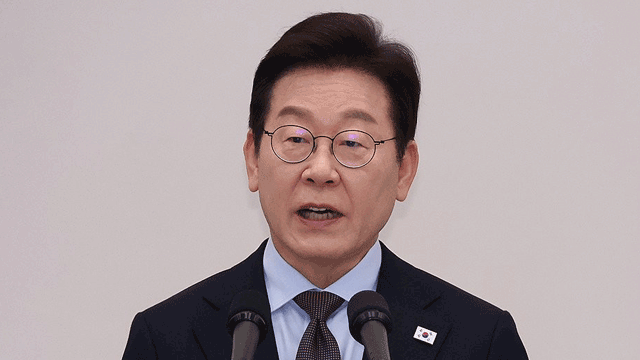[Anchor]
There is a symbolic event where our farmers strongly resisted the rice plundering policy of the Japanese colonial rule during the Japanese occupation period.
This is the anti-Japanese farmers' movement that took place in Naju.
KBS has exclusively obtained photographs from that time.
The photos taken by the Governor-General of Korea are being revealed for the first time by reporter Noh Tae-young.
[Report]
There is a monument standing on one side of the national road by the Yeongsan River.
The 'Naju Anti-Japanese Farmers' Movement Monument' commemorates the struggle of farmers from Gungsam-myeon who resisted the confiscation of their land by the Japanese.
More than 10,000 farmers participated, and it became a symbolic event of the anti-Japanese farmers' movement, such as the refusal to pay rent.
[Yoon Yeo-jeong/Director of Naju Cultural Center: "What people need most to live is farmland. But that land was taken away by others, it was plundered, they were robbed. That is unfair to those people."]
Faded black-and-white photographs.
On the platform stands the head of the police department of the Governor-General of Korea, a symbol of colonial oppression, while farmers are seen sitting on the ground with their heads bowed.
The words 'Year 15 of the Great Japan Empire,' referring to the year 1926, and 'Gungsam-myeon Incident' are also clearly visible.
These are photographs from the Gungsam-myeon farmers' movement that have been revealed after 99 years.
[Han Cheol-soo/Former Consul of the Republic of Korea in Osaka: "If the refusal to cultivate spread, it was a serious issue that could threaten Japan's food security. A high-ranking official from the police department of the Governor-General had no choice but to come down."]
This is considered an important moment in the anti-Japanese farmers' movement, where the Governor-General presented a negotiation proposal in response to the farmers' fierce backlash.
[Han Cheol-soo/Former Consul of the Republic of Korea in Osaka: "This is a photo symbolizing a rare victory in the anti-Japanese farmers' movement, where they managed to recover some of the land that had been taken away by defeating the Governor-General."]
This historically significant photo was discovered among the belongings of Tanaka Takeo, head of the police department of the Governor-General of Korea at the time, and is currently held by a Japanese collector.
KBS News, Noh Tae-young.
There is a symbolic event where our farmers strongly resisted the rice plundering policy of the Japanese colonial rule during the Japanese occupation period.
This is the anti-Japanese farmers' movement that took place in Naju.
KBS has exclusively obtained photographs from that time.
The photos taken by the Governor-General of Korea are being revealed for the first time by reporter Noh Tae-young.
[Report]
There is a monument standing on one side of the national road by the Yeongsan River.
The 'Naju Anti-Japanese Farmers' Movement Monument' commemorates the struggle of farmers from Gungsam-myeon who resisted the confiscation of their land by the Japanese.
More than 10,000 farmers participated, and it became a symbolic event of the anti-Japanese farmers' movement, such as the refusal to pay rent.
[Yoon Yeo-jeong/Director of Naju Cultural Center: "What people need most to live is farmland. But that land was taken away by others, it was plundered, they were robbed. That is unfair to those people."]
Faded black-and-white photographs.
On the platform stands the head of the police department of the Governor-General of Korea, a symbol of colonial oppression, while farmers are seen sitting on the ground with their heads bowed.
The words 'Year 15 of the Great Japan Empire,' referring to the year 1926, and 'Gungsam-myeon Incident' are also clearly visible.
These are photographs from the Gungsam-myeon farmers' movement that have been revealed after 99 years.
[Han Cheol-soo/Former Consul of the Republic of Korea in Osaka: "If the refusal to cultivate spread, it was a serious issue that could threaten Japan's food security. A high-ranking official from the police department of the Governor-General had no choice but to come down."]
This is considered an important moment in the anti-Japanese farmers' movement, where the Governor-General presented a negotiation proposal in response to the farmers' fierce backlash.
[Han Cheol-soo/Former Consul of the Republic of Korea in Osaka: "This is a photo symbolizing a rare victory in the anti-Japanese farmers' movement, where they managed to recover some of the land that had been taken away by defeating the Governor-General."]
This historically significant photo was discovered among the belongings of Tanaka Takeo, head of the police department of the Governor-General of Korea at the time, and is currently held by a Japanese collector.
KBS News, Noh Tae-young.
■ 제보하기
▷ 카카오톡 : 'KBS제보' 검색, 채널 추가
▷ 전화 : 02-781-1234, 4444
▷ 이메일 : kbs1234@kbs.co.kr
▷ 유튜브, 네이버, 카카오에서도 KBS뉴스를 구독해주세요!
- Photo reveals farmers' resistance
-
- 입력 2025-08-15 00:49:46

[Anchor]
There is a symbolic event where our farmers strongly resisted the rice plundering policy of the Japanese colonial rule during the Japanese occupation period.
This is the anti-Japanese farmers' movement that took place in Naju.
KBS has exclusively obtained photographs from that time.
The photos taken by the Governor-General of Korea are being revealed for the first time by reporter Noh Tae-young.
[Report]
There is a monument standing on one side of the national road by the Yeongsan River.
The 'Naju Anti-Japanese Farmers' Movement Monument' commemorates the struggle of farmers from Gungsam-myeon who resisted the confiscation of their land by the Japanese.
More than 10,000 farmers participated, and it became a symbolic event of the anti-Japanese farmers' movement, such as the refusal to pay rent.
[Yoon Yeo-jeong/Director of Naju Cultural Center: "What people need most to live is farmland. But that land was taken away by others, it was plundered, they were robbed. That is unfair to those people."]
Faded black-and-white photographs.
On the platform stands the head of the police department of the Governor-General of Korea, a symbol of colonial oppression, while farmers are seen sitting on the ground with their heads bowed.
The words 'Year 15 of the Great Japan Empire,' referring to the year 1926, and 'Gungsam-myeon Incident' are also clearly visible.
These are photographs from the Gungsam-myeon farmers' movement that have been revealed after 99 years.
[Han Cheol-soo/Former Consul of the Republic of Korea in Osaka: "If the refusal to cultivate spread, it was a serious issue that could threaten Japan's food security. A high-ranking official from the police department of the Governor-General had no choice but to come down."]
This is considered an important moment in the anti-Japanese farmers' movement, where the Governor-General presented a negotiation proposal in response to the farmers' fierce backlash.
[Han Cheol-soo/Former Consul of the Republic of Korea in Osaka: "This is a photo symbolizing a rare victory in the anti-Japanese farmers' movement, where they managed to recover some of the land that had been taken away by defeating the Governor-General."]
This historically significant photo was discovered among the belongings of Tanaka Takeo, head of the police department of the Governor-General of Korea at the time, and is currently held by a Japanese collector.
KBS News, Noh Tae-young.
There is a symbolic event where our farmers strongly resisted the rice plundering policy of the Japanese colonial rule during the Japanese occupation period.
This is the anti-Japanese farmers' movement that took place in Naju.
KBS has exclusively obtained photographs from that time.
The photos taken by the Governor-General of Korea are being revealed for the first time by reporter Noh Tae-young.
[Report]
There is a monument standing on one side of the national road by the Yeongsan River.
The 'Naju Anti-Japanese Farmers' Movement Monument' commemorates the struggle of farmers from Gungsam-myeon who resisted the confiscation of their land by the Japanese.
More than 10,000 farmers participated, and it became a symbolic event of the anti-Japanese farmers' movement, such as the refusal to pay rent.
[Yoon Yeo-jeong/Director of Naju Cultural Center: "What people need most to live is farmland. But that land was taken away by others, it was plundered, they were robbed. That is unfair to those people."]
Faded black-and-white photographs.
On the platform stands the head of the police department of the Governor-General of Korea, a symbol of colonial oppression, while farmers are seen sitting on the ground with their heads bowed.
The words 'Year 15 of the Great Japan Empire,' referring to the year 1926, and 'Gungsam-myeon Incident' are also clearly visible.
These are photographs from the Gungsam-myeon farmers' movement that have been revealed after 99 years.
[Han Cheol-soo/Former Consul of the Republic of Korea in Osaka: "If the refusal to cultivate spread, it was a serious issue that could threaten Japan's food security. A high-ranking official from the police department of the Governor-General had no choice but to come down."]
This is considered an important moment in the anti-Japanese farmers' movement, where the Governor-General presented a negotiation proposal in response to the farmers' fierce backlash.
[Han Cheol-soo/Former Consul of the Republic of Korea in Osaka: "This is a photo symbolizing a rare victory in the anti-Japanese farmers' movement, where they managed to recover some of the land that had been taken away by defeating the Governor-General."]
This historically significant photo was discovered among the belongings of Tanaka Takeo, head of the police department of the Governor-General of Korea at the time, and is currently held by a Japanese collector.
KBS News, Noh Tae-young.
-
-

노태영 기자 lotte0@kbs.co.kr
노태영 기자의 기사 모음
-
이 기사가 좋으셨다면
-
좋아요
0
-
응원해요
0
-
후속 원해요
0















이 기사에 대한 의견을 남겨주세요.